Business Law: Analysis of Negligence and Duty of Care Case
VerifiedAdded on 2023/06/09
|7
|2341
|85
Report
AI Summary
This document presents a legal opinion on a business law case involving negligence and duty of care, focusing on whether Susan can be held liable for damages caused by her Bengal tiger, Benji. The analysis follows the IRAC structure, evaluating the merits of the case for both parties. It examines the elements of negligence, including duty of care, breach of duty, causation, and remoteness of damages, referencing key legal precedents such as Donoghue v Stevenson, Caparo Industries Plc v Dickman, and Overseas Tankship (UK) Ltd v Morts Dock & Engineering Co Ltd. The application section analyzes the specific facts of the case, considering the proximity of the relationship between Susan and her neighbors, and whether Susan breached her duty of care. Ultimately, the report concludes that Susan is likely not liable for the damages suffered by her neighbors because she maintained a standard of care, and the tiger was released by a third party without her knowledge. The document provides a detailed legal analysis, complete with references, to support its conclusions.
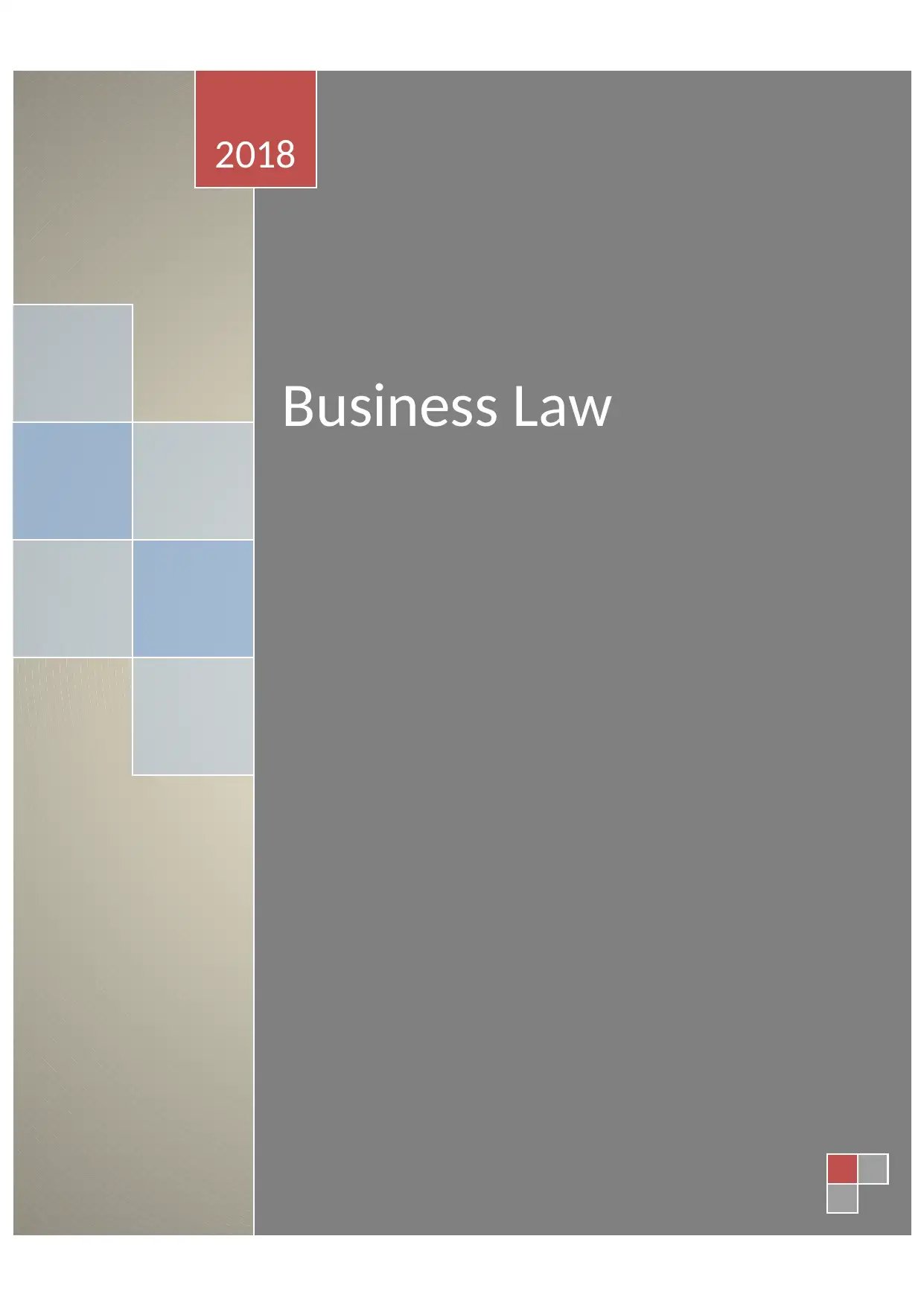
Business Law
2018
2018
Paraphrase This Document
Need a fresh take? Get an instant paraphrase of this document with our AI Paraphraser
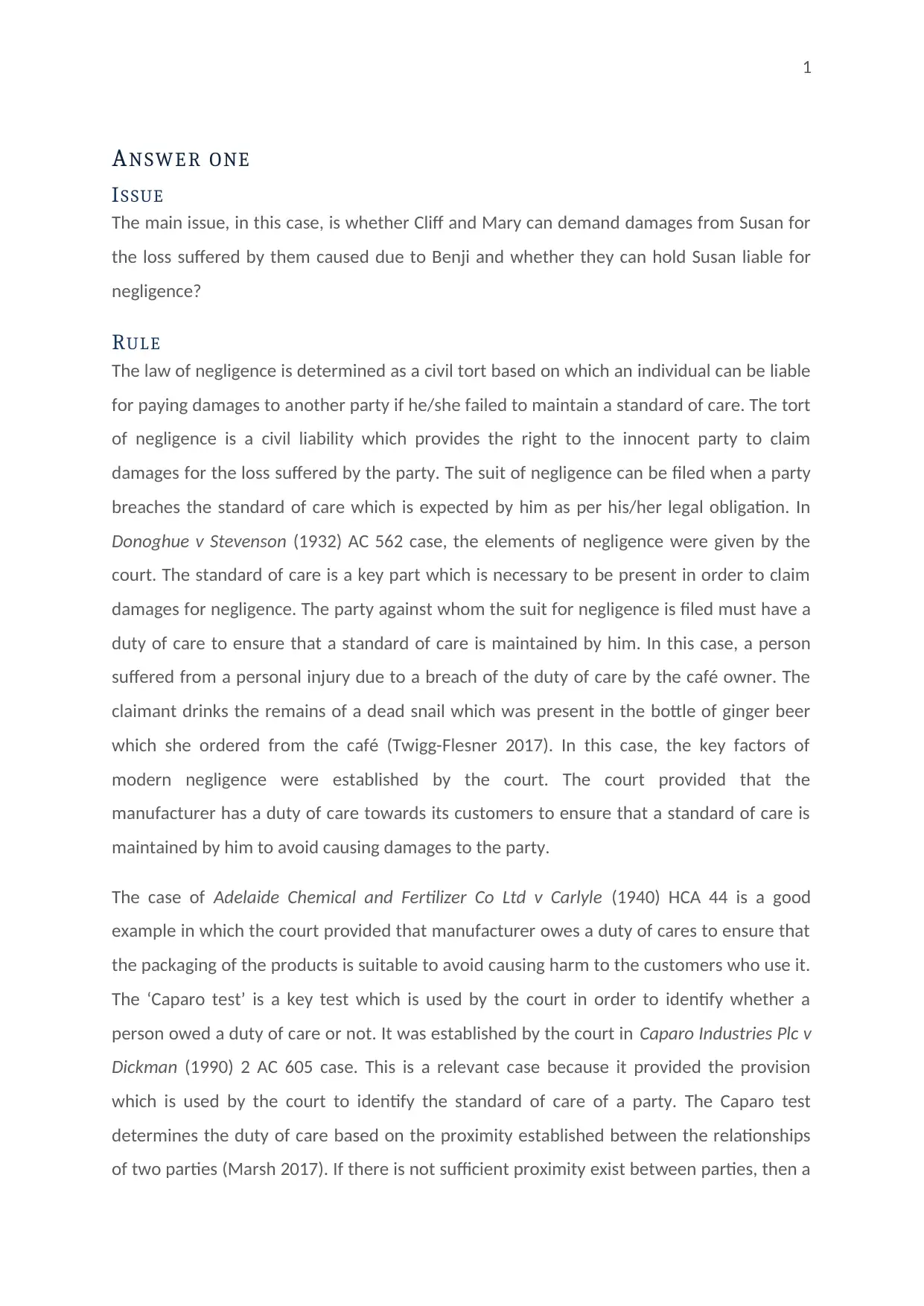
1
ANSWER ONE
ISSUE
The main issue, in this case, is whether Cliff and Mary can demand damages from Susan for
the loss suffered by them caused due to Benji and whether they can hold Susan liable for
negligence?
RULE
The law of negligence is determined as a civil tort based on which an individual can be liable
for paying damages to another party if he/she failed to maintain a standard of care. The tort
of negligence is a civil liability which provides the right to the innocent party to claim
damages for the loss suffered by the party. The suit of negligence can be filed when a party
breaches the standard of care which is expected by him as per his/her legal obligation. In
Donoghue v Stevenson (1932) AC 562 case, the elements of negligence were given by the
court. The standard of care is a key part which is necessary to be present in order to claim
damages for negligence. The party against whom the suit for negligence is filed must have a
duty of care to ensure that a standard of care is maintained by him. In this case, a person
suffered from a personal injury due to a breach of the duty of care by the café owner. The
claimant drinks the remains of a dead snail which was present in the bottle of ginger beer
which she ordered from the café (Twigg-Flesner 2017). In this case, the key factors of
modern negligence were established by the court. The court provided that the
manufacturer has a duty of care towards its customers to ensure that a standard of care is
maintained by him to avoid causing damages to the party.
The case of Adelaide Chemical and Fertilizer Co Ltd v Carlyle (1940) HCA 44 is a good
example in which the court provided that manufacturer owes a duty of cares to ensure that
the packaging of the products is suitable to avoid causing harm to the customers who use it.
The ‘Caparo test’ is a key test which is used by the court in order to identify whether a
person owed a duty of care or not. It was established by the court in Caparo Industries Plc v
Dickman (1990) 2 AC 605 case. This is a relevant case because it provided the provision
which is used by the court to identify the standard of care of a party. The Caparo test
determines the duty of care based on the proximity established between the relationships
of two parties (Marsh 2017). If there is not sufficient proximity exist between parties, then a
ANSWER ONE
ISSUE
The main issue, in this case, is whether Cliff and Mary can demand damages from Susan for
the loss suffered by them caused due to Benji and whether they can hold Susan liable for
negligence?
RULE
The law of negligence is determined as a civil tort based on which an individual can be liable
for paying damages to another party if he/she failed to maintain a standard of care. The tort
of negligence is a civil liability which provides the right to the innocent party to claim
damages for the loss suffered by the party. The suit of negligence can be filed when a party
breaches the standard of care which is expected by him as per his/her legal obligation. In
Donoghue v Stevenson (1932) AC 562 case, the elements of negligence were given by the
court. The standard of care is a key part which is necessary to be present in order to claim
damages for negligence. The party against whom the suit for negligence is filed must have a
duty of care to ensure that a standard of care is maintained by him. In this case, a person
suffered from a personal injury due to a breach of the duty of care by the café owner. The
claimant drinks the remains of a dead snail which was present in the bottle of ginger beer
which she ordered from the café (Twigg-Flesner 2017). In this case, the key factors of
modern negligence were established by the court. The court provided that the
manufacturer has a duty of care towards its customers to ensure that a standard of care is
maintained by him to avoid causing damages to the party.
The case of Adelaide Chemical and Fertilizer Co Ltd v Carlyle (1940) HCA 44 is a good
example in which the court provided that manufacturer owes a duty of cares to ensure that
the packaging of the products is suitable to avoid causing harm to the customers who use it.
The ‘Caparo test’ is a key test which is used by the court in order to identify whether a
person owed a duty of care or not. It was established by the court in Caparo Industries Plc v
Dickman (1990) 2 AC 605 case. This is a relevant case because it provided the provision
which is used by the court to identify the standard of care of a party. The Caparo test
determines the duty of care based on the proximity established between the relationships
of two parties (Marsh 2017). If there is not sufficient proximity exist between parties, then a
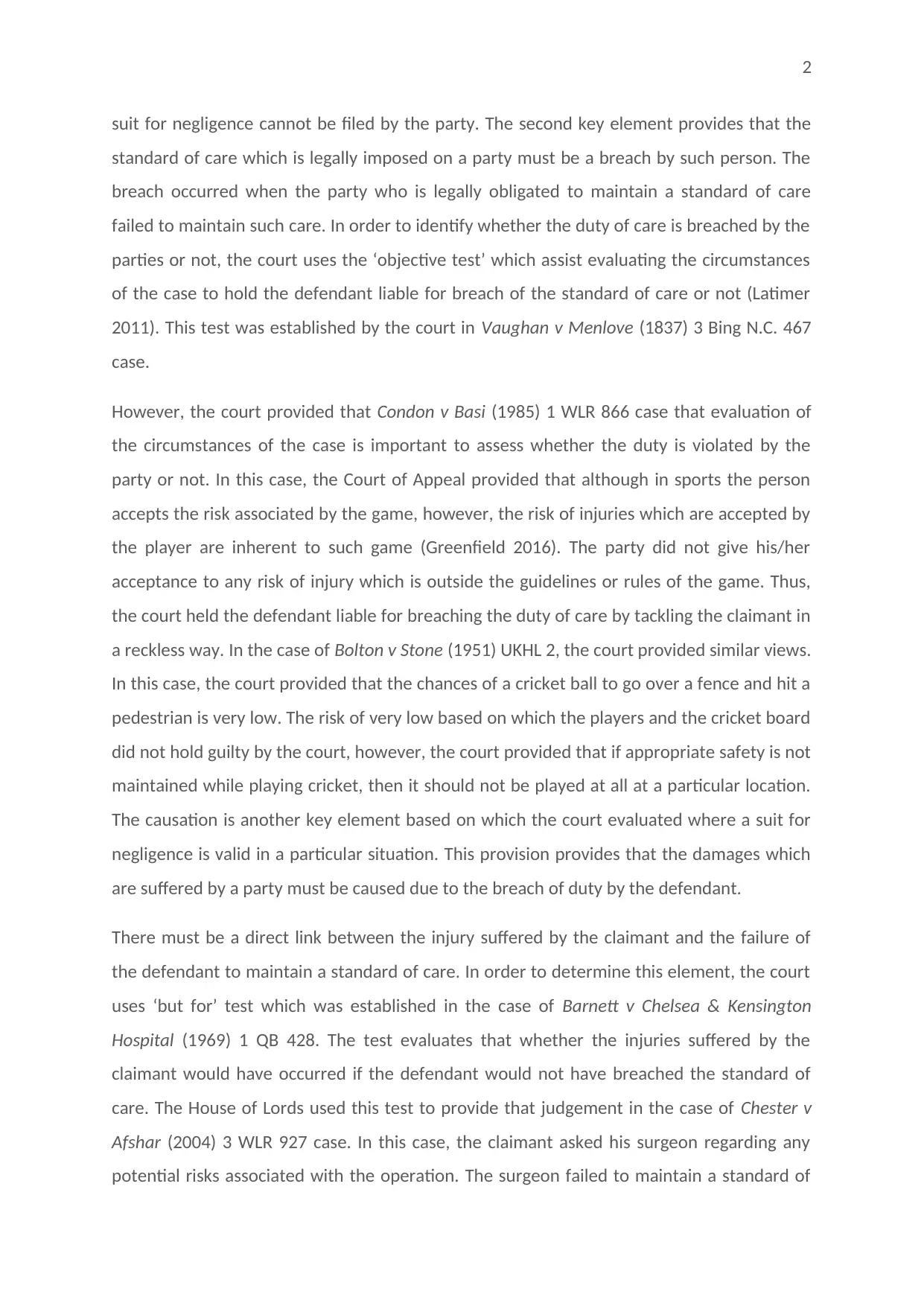
2
suit for negligence cannot be filed by the party. The second key element provides that the
standard of care which is legally imposed on a party must be a breach by such person. The
breach occurred when the party who is legally obligated to maintain a standard of care
failed to maintain such care. In order to identify whether the duty of care is breached by the
parties or not, the court uses the ‘objective test’ which assist evaluating the circumstances
of the case to hold the defendant liable for breach of the standard of care or not (Latimer
2011). This test was established by the court in Vaughan v Menlove (1837) 3 Bing N.C. 467
case.
However, the court provided that Condon v Basi (1985) 1 WLR 866 case that evaluation of
the circumstances of the case is important to assess whether the duty is violated by the
party or not. In this case, the Court of Appeal provided that although in sports the person
accepts the risk associated by the game, however, the risk of injuries which are accepted by
the player are inherent to such game (Greenfield 2016). The party did not give his/her
acceptance to any risk of injury which is outside the guidelines or rules of the game. Thus,
the court held the defendant liable for breaching the duty of care by tackling the claimant in
a reckless way. In the case of Bolton v Stone (1951) UKHL 2, the court provided similar views.
In this case, the court provided that the chances of a cricket ball to go over a fence and hit a
pedestrian is very low. The risk of very low based on which the players and the cricket board
did not hold guilty by the court, however, the court provided that if appropriate safety is not
maintained while playing cricket, then it should not be played at all at a particular location.
The causation is another key element based on which the court evaluated where a suit for
negligence is valid in a particular situation. This provision provides that the damages which
are suffered by a party must be caused due to the breach of duty by the defendant.
There must be a direct link between the injury suffered by the claimant and the failure of
the defendant to maintain a standard of care. In order to determine this element, the court
uses ‘but for’ test which was established in the case of Barnett v Chelsea & Kensington
Hospital (1969) 1 QB 428. The test evaluates that whether the injuries suffered by the
claimant would have occurred if the defendant would not have breached the standard of
care. The House of Lords used this test to provide that judgement in the case of Chester v
Afshar (2004) 3 WLR 927 case. In this case, the claimant asked his surgeon regarding any
potential risks associated with the operation. The surgeon failed to maintain a standard of
suit for negligence cannot be filed by the party. The second key element provides that the
standard of care which is legally imposed on a party must be a breach by such person. The
breach occurred when the party who is legally obligated to maintain a standard of care
failed to maintain such care. In order to identify whether the duty of care is breached by the
parties or not, the court uses the ‘objective test’ which assist evaluating the circumstances
of the case to hold the defendant liable for breach of the standard of care or not (Latimer
2011). This test was established by the court in Vaughan v Menlove (1837) 3 Bing N.C. 467
case.
However, the court provided that Condon v Basi (1985) 1 WLR 866 case that evaluation of
the circumstances of the case is important to assess whether the duty is violated by the
party or not. In this case, the Court of Appeal provided that although in sports the person
accepts the risk associated by the game, however, the risk of injuries which are accepted by
the player are inherent to such game (Greenfield 2016). The party did not give his/her
acceptance to any risk of injury which is outside the guidelines or rules of the game. Thus,
the court held the defendant liable for breaching the duty of care by tackling the claimant in
a reckless way. In the case of Bolton v Stone (1951) UKHL 2, the court provided similar views.
In this case, the court provided that the chances of a cricket ball to go over a fence and hit a
pedestrian is very low. The risk of very low based on which the players and the cricket board
did not hold guilty by the court, however, the court provided that if appropriate safety is not
maintained while playing cricket, then it should not be played at all at a particular location.
The causation is another key element based on which the court evaluated where a suit for
negligence is valid in a particular situation. This provision provides that the damages which
are suffered by a party must be caused due to the breach of duty by the defendant.
There must be a direct link between the injury suffered by the claimant and the failure of
the defendant to maintain a standard of care. In order to determine this element, the court
uses ‘but for’ test which was established in the case of Barnett v Chelsea & Kensington
Hospital (1969) 1 QB 428. The test evaluates that whether the injuries suffered by the
claimant would have occurred if the defendant would not have breached the standard of
care. The House of Lords used this test to provide that judgement in the case of Chester v
Afshar (2004) 3 WLR 927 case. In this case, the claimant asked his surgeon regarding any
potential risks associated with the operation. The surgeon failed to maintain a standard of
⊘ This is a preview!⊘
Do you want full access?
Subscribe today to unlock all pages.

Trusted by 1+ million students worldwide
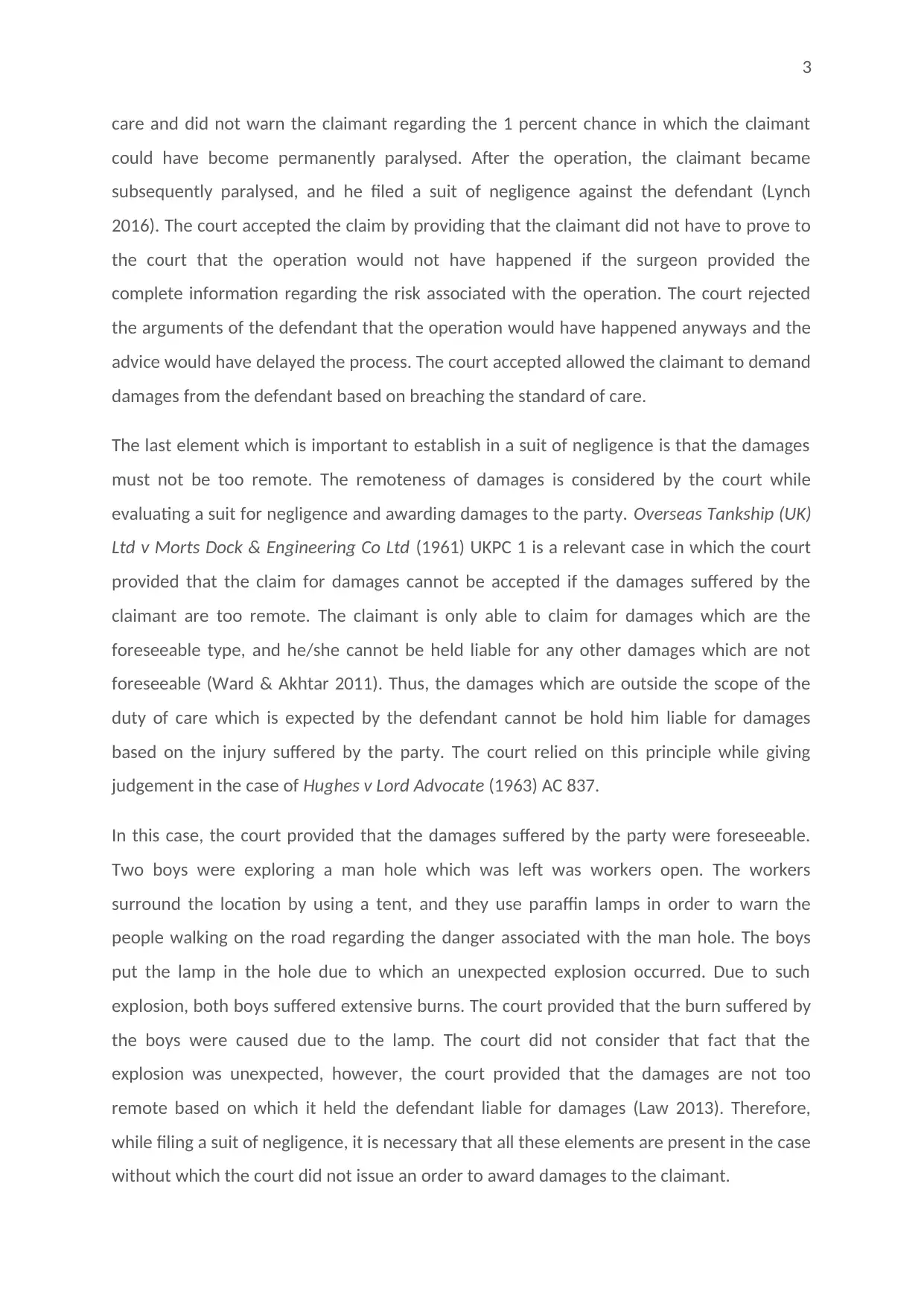
3
care and did not warn the claimant regarding the 1 percent chance in which the claimant
could have become permanently paralysed. After the operation, the claimant became
subsequently paralysed, and he filed a suit of negligence against the defendant (Lynch
2016). The court accepted the claim by providing that the claimant did not have to prove to
the court that the operation would not have happened if the surgeon provided the
complete information regarding the risk associated with the operation. The court rejected
the arguments of the defendant that the operation would have happened anyways and the
advice would have delayed the process. The court accepted allowed the claimant to demand
damages from the defendant based on breaching the standard of care.
The last element which is important to establish in a suit of negligence is that the damages
must not be too remote. The remoteness of damages is considered by the court while
evaluating a suit for negligence and awarding damages to the party. Overseas Tankship (UK)
Ltd v Morts Dock & Engineering Co Ltd (1961) UKPC 1 is a relevant case in which the court
provided that the claim for damages cannot be accepted if the damages suffered by the
claimant are too remote. The claimant is only able to claim for damages which are the
foreseeable type, and he/she cannot be held liable for any other damages which are not
foreseeable (Ward & Akhtar 2011). Thus, the damages which are outside the scope of the
duty of care which is expected by the defendant cannot be hold him liable for damages
based on the injury suffered by the party. The court relied on this principle while giving
judgement in the case of Hughes v Lord Advocate (1963) AC 837.
In this case, the court provided that the damages suffered by the party were foreseeable.
Two boys were exploring a man hole which was left was workers open. The workers
surround the location by using a tent, and they use paraffin lamps in order to warn the
people walking on the road regarding the danger associated with the man hole. The boys
put the lamp in the hole due to which an unexpected explosion occurred. Due to such
explosion, both boys suffered extensive burns. The court provided that the burn suffered by
the boys were caused due to the lamp. The court did not consider that fact that the
explosion was unexpected, however, the court provided that the damages are not too
remote based on which it held the defendant liable for damages (Law 2013). Therefore,
while filing a suit of negligence, it is necessary that all these elements are present in the case
without which the court did not issue an order to award damages to the claimant.
care and did not warn the claimant regarding the 1 percent chance in which the claimant
could have become permanently paralysed. After the operation, the claimant became
subsequently paralysed, and he filed a suit of negligence against the defendant (Lynch
2016). The court accepted the claim by providing that the claimant did not have to prove to
the court that the operation would not have happened if the surgeon provided the
complete information regarding the risk associated with the operation. The court rejected
the arguments of the defendant that the operation would have happened anyways and the
advice would have delayed the process. The court accepted allowed the claimant to demand
damages from the defendant based on breaching the standard of care.
The last element which is important to establish in a suit of negligence is that the damages
must not be too remote. The remoteness of damages is considered by the court while
evaluating a suit for negligence and awarding damages to the party. Overseas Tankship (UK)
Ltd v Morts Dock & Engineering Co Ltd (1961) UKPC 1 is a relevant case in which the court
provided that the claim for damages cannot be accepted if the damages suffered by the
claimant are too remote. The claimant is only able to claim for damages which are the
foreseeable type, and he/she cannot be held liable for any other damages which are not
foreseeable (Ward & Akhtar 2011). Thus, the damages which are outside the scope of the
duty of care which is expected by the defendant cannot be hold him liable for damages
based on the injury suffered by the party. The court relied on this principle while giving
judgement in the case of Hughes v Lord Advocate (1963) AC 837.
In this case, the court provided that the damages suffered by the party were foreseeable.
Two boys were exploring a man hole which was left was workers open. The workers
surround the location by using a tent, and they use paraffin lamps in order to warn the
people walking on the road regarding the danger associated with the man hole. The boys
put the lamp in the hole due to which an unexpected explosion occurred. Due to such
explosion, both boys suffered extensive burns. The court provided that the burn suffered by
the boys were caused due to the lamp. The court did not consider that fact that the
explosion was unexpected, however, the court provided that the damages are not too
remote based on which it held the defendant liable for damages (Law 2013). Therefore,
while filing a suit of negligence, it is necessary that all these elements are present in the case
without which the court did not issue an order to award damages to the claimant.
Paraphrase This Document
Need a fresh take? Get an instant paraphrase of this document with our AI Paraphraser

4
APPLICATION
In this case, a substantial loss is suffered by Cliff and Mary that is caused by Benji. Benji is a
tiger, and she can cause serious injury to parties based on which Susan has a duty of care to
ensure that she kept him away from others. Based on the Caparo test, there is proximity to
the relationship between Susan and Cliff and Mary since they are neighbours (Caparo
Industries Plc v Dickman). Thus, Susan owed a duty of care towards them in order to ensure
that Benji did not cause any damages to them or their property (Donoghue v Stevenson).
The damages which suffered by Cliff and Mary were caused due to Benji. The damages were
not too remote as well since Benji is a big tiger which can cause serious damage to another
party. However, Cliff and Mary cannot claim damages from Susan and cannot hold her liable
for negligence because she did not breach her duty of care. Based on the Caparo test, it was
a legal duty for Susan to ensure that Benji is kept away from other parties in order to ensure
that she did not cause any harm to others. Based on such duty, Susan kept Benji is a strong
compound which is enough to hold her away from others.
Furthermore, Susan also has appropriate papers for Benji. The compound of Benji was
opened by Kim, daughter of Cliff and Mary, who did not know that it can be dangerous.
Susan had ensured that Benji is in her compound, and she was away when Kim opened the
compound of Susan without her knowledge. Cliff and Mary should not let their child visit
Susan’s house without proper guidance. Kim opened the compound of Benji and let her out
without the supervision of anyone. Therefore, Susan did not breach his duty of care since
Benji was released by Kim without her knowledge. Based on this fact, Cliff and Mary cannot
hold Susan liable for the damages suffered by them which are caused because Benji was
released by Kim. They should not let Kim visit Susan’s house since she is just a child who did
not understand the consequences of her actions. A suit for negligence cannot be filed
against Susan by Cliff and Mary for the damages which they suffered due to the release of
Benji. Susan can prove in the court that she has maintained a standard of care which is
expected from her and the damages were not result of the breach of duty by her based on
which she is not liable for paying damages.
CONCLUSION
Based on the above analysis, Cliff and Mary cannot demand damages from Susan since the
damages suffered by them did not cause due to the breach of duty by Susan. Susan is not
APPLICATION
In this case, a substantial loss is suffered by Cliff and Mary that is caused by Benji. Benji is a
tiger, and she can cause serious injury to parties based on which Susan has a duty of care to
ensure that she kept him away from others. Based on the Caparo test, there is proximity to
the relationship between Susan and Cliff and Mary since they are neighbours (Caparo
Industries Plc v Dickman). Thus, Susan owed a duty of care towards them in order to ensure
that Benji did not cause any damages to them or their property (Donoghue v Stevenson).
The damages which suffered by Cliff and Mary were caused due to Benji. The damages were
not too remote as well since Benji is a big tiger which can cause serious damage to another
party. However, Cliff and Mary cannot claim damages from Susan and cannot hold her liable
for negligence because she did not breach her duty of care. Based on the Caparo test, it was
a legal duty for Susan to ensure that Benji is kept away from other parties in order to ensure
that she did not cause any harm to others. Based on such duty, Susan kept Benji is a strong
compound which is enough to hold her away from others.
Furthermore, Susan also has appropriate papers for Benji. The compound of Benji was
opened by Kim, daughter of Cliff and Mary, who did not know that it can be dangerous.
Susan had ensured that Benji is in her compound, and she was away when Kim opened the
compound of Susan without her knowledge. Cliff and Mary should not let their child visit
Susan’s house without proper guidance. Kim opened the compound of Benji and let her out
without the supervision of anyone. Therefore, Susan did not breach his duty of care since
Benji was released by Kim without her knowledge. Based on this fact, Cliff and Mary cannot
hold Susan liable for the damages suffered by them which are caused because Benji was
released by Kim. They should not let Kim visit Susan’s house since she is just a child who did
not understand the consequences of her actions. A suit for negligence cannot be filed
against Susan by Cliff and Mary for the damages which they suffered due to the release of
Benji. Susan can prove in the court that she has maintained a standard of care which is
expected from her and the damages were not result of the breach of duty by her based on
which she is not liable for paying damages.
CONCLUSION
Based on the above analysis, Cliff and Mary cannot demand damages from Susan since the
damages suffered by them did not cause due to the breach of duty by Susan. Susan is not
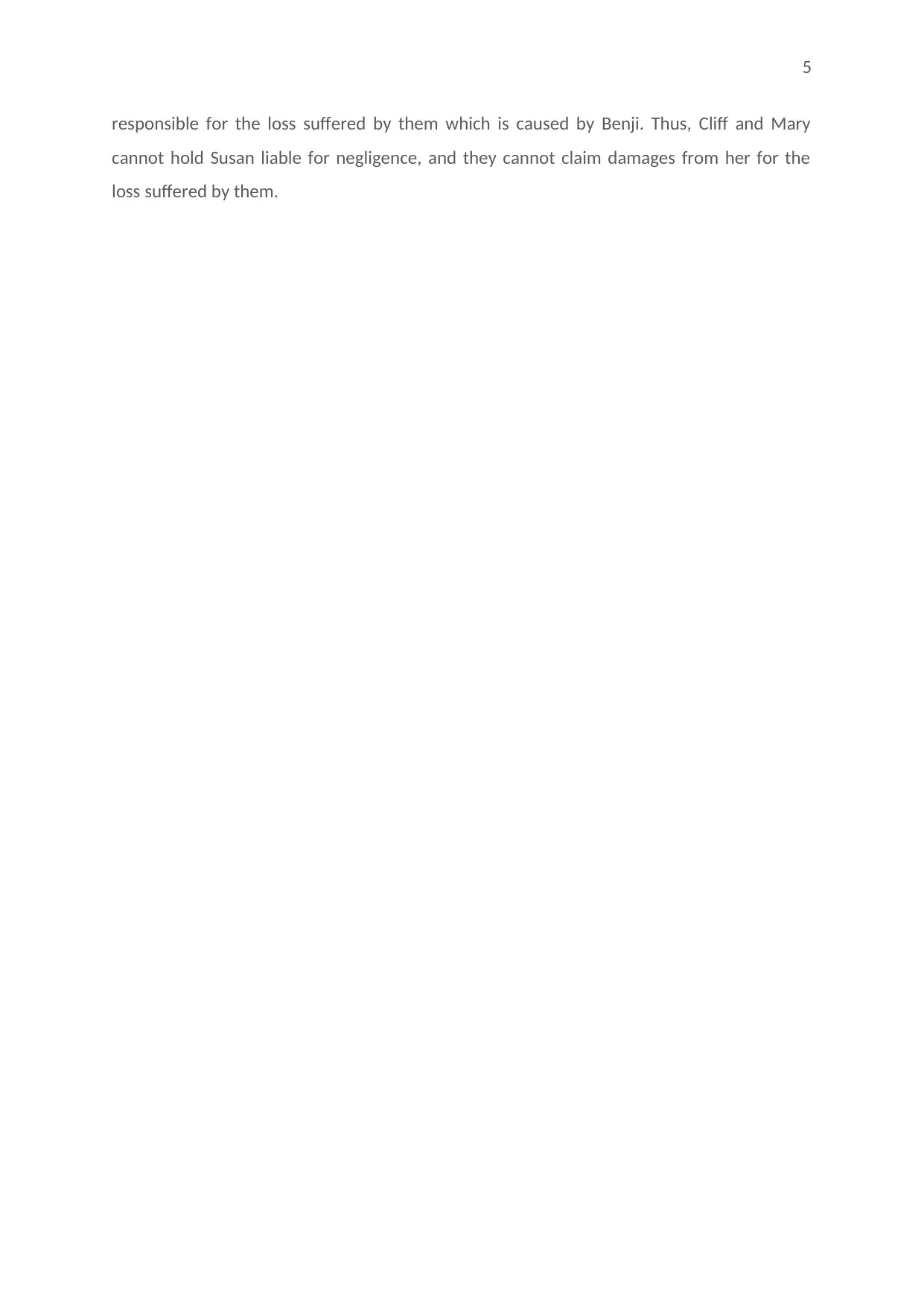
5
responsible for the loss suffered by them which is caused by Benji. Thus, Cliff and Mary
cannot hold Susan liable for negligence, and they cannot claim damages from her for the
loss suffered by them.
responsible for the loss suffered by them which is caused by Benji. Thus, Cliff and Mary
cannot hold Susan liable for negligence, and they cannot claim damages from her for the
loss suffered by them.
⊘ This is a preview!⊘
Do you want full access?
Subscribe today to unlock all pages.

Trusted by 1+ million students worldwide

6
REFERENCES
Adelaide Chemical and Fertilizer Co Ltd v Carlyle (1940) HCA 44
Barnett v Chelsea & Kensington Hospital (1969) 1 QB 428
Bolton v Stone (1951) UKHL 2
Caparo Industries Plc v Dickman (1990) 2 AC 605
Chester v Afshar (2004) 3 WLR 927
Condon v Basi (1985) 1 WLR 866
Donoghue v Stevenson (1932) AC 562
Greenfield, S 2016, ‘Legal Cultures and the Regulation of Coaching Practice: Different
Jurisdictions, Different Approaches?’, Staps, no. 4, pp. 87-96.
Hughes v Lord Advocate (1963) AC 837
Latimer, P 2011, Australian Business Law 2012, CCH Australia Limited, Macquarie Park,
NSW.
Law, DC 2013, ‘Legal Domains and Comparative Law’, The Edinburgh Law Review, vol. 17,
pp. 420-430.
Lynch, J 2016, Consent to treatment, CRC Press, Florida.
Marsh, P 2017, Contracting for engineering and construction projects, Routledge, Abingdon.
Overseas Tankship (UK) Ltd v Morts Dock & Engineering Co Ltd (1961) UKPC 1
Twigg-Flesner, C 2017, Consumer product guarantees, Routledge, Abingdon.
Vaughan v Menlove (1837) 3 Bing N.C. 467
Ward, R & Akhtar, A 2011, Walker & Walker's English legal system, Oxford University Press,
Oxford.
REFERENCES
Adelaide Chemical and Fertilizer Co Ltd v Carlyle (1940) HCA 44
Barnett v Chelsea & Kensington Hospital (1969) 1 QB 428
Bolton v Stone (1951) UKHL 2
Caparo Industries Plc v Dickman (1990) 2 AC 605
Chester v Afshar (2004) 3 WLR 927
Condon v Basi (1985) 1 WLR 866
Donoghue v Stevenson (1932) AC 562
Greenfield, S 2016, ‘Legal Cultures and the Regulation of Coaching Practice: Different
Jurisdictions, Different Approaches?’, Staps, no. 4, pp. 87-96.
Hughes v Lord Advocate (1963) AC 837
Latimer, P 2011, Australian Business Law 2012, CCH Australia Limited, Macquarie Park,
NSW.
Law, DC 2013, ‘Legal Domains and Comparative Law’, The Edinburgh Law Review, vol. 17,
pp. 420-430.
Lynch, J 2016, Consent to treatment, CRC Press, Florida.
Marsh, P 2017, Contracting for engineering and construction projects, Routledge, Abingdon.
Overseas Tankship (UK) Ltd v Morts Dock & Engineering Co Ltd (1961) UKPC 1
Twigg-Flesner, C 2017, Consumer product guarantees, Routledge, Abingdon.
Vaughan v Menlove (1837) 3 Bing N.C. 467
Ward, R & Akhtar, A 2011, Walker & Walker's English legal system, Oxford University Press,
Oxford.
1 out of 7
Related Documents
Your All-in-One AI-Powered Toolkit for Academic Success.
+13062052269
info@desklib.com
Available 24*7 on WhatsApp / Email
![[object Object]](/_next/static/media/star-bottom.7253800d.svg)
Unlock your academic potential
Copyright © 2020–2025 A2Z Services. All Rights Reserved. Developed and managed by ZUCOL.




